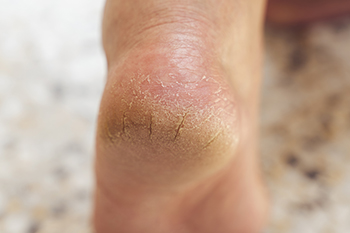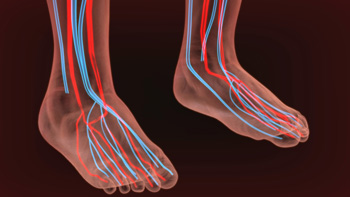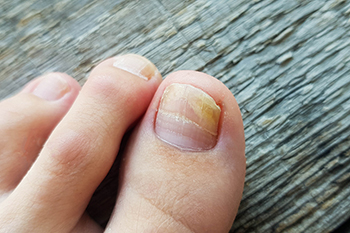Wesley Chapel
(813) 973-3535Call or Text
November 2023
Vital Insights About Ankle Sprains

Ankle sprains, though common, are often underestimated in their impact on our daily lives. Understanding these injuries is pivotal for everyone, from athletes to the average person navigating routine activities. Ankle sprains occur when the ligaments supporting the ankle stretch beyond their limits, often due to a sudden twist or turn. The severity varies, with mild sprains causing discomfort and swelling, while more severe cases may lead to instability and difficulty walking. Recognizing the signs, including pain, swelling, and bruising, is essential for prompt intervention. Ignoring ankle sprains or not providing adequate care can lead to long-term complications, such as chronic instability or arthritis. If you have endured an ankle sprain, it is suggested that you visit a podiatrist who can properly diagnose and effectively treat this condition.
Although ankle sprains are common, they aren’t always minor injuries. If you need your ankle injury looked at, contact one of our podiatrists from New Tampa Foot & Ankle. Our doctors can provide the care you need to keep you pain-free and on your feet.
How Does an Ankle Sprain Occur?
Ankle sprains are the result of a tear in the ligaments within the ankle. These injuries may happen when you make a rapid shifting movement while your foot is planted. A less common way to sprain your ankle is when your ankle rolls inward while your foot turns outward.
What Are the Symptoms?
- Pain at the sight of the tear
- Bruising/Swelling
- Ankle area is tender to touch
- In severe cases, may hear/feel something tear
- Skin discoloration
Preventing a Sprain
- Wearing appropriate shoes for the occasion
- Stretching before exercises and sports
- Knowing your limits
Treatment of a Sprain
In many cases, the RICE method (Rest, Ice, Compression, and Elevate) is used to treat ankle sprains. However, you should see a podiatrist to see which treatment option would work best with your injury. In severe cases, surgery may be required.
It is important to ask your doctor about rehab options after you receive treatment for your injury. Stretching, strength training, and balance exercises may help the ankle heal while also preventing further injury.
If you have any questions, please feel free to contact our office located in Wesley Chapel, FL . We offer the newest diagnostic and treatment technologies for all your foot care needs.
The Seriousness of Cracked Heels

Cracked heels, medically known as heel fissures, are more than just a cosmetic issue, they can be quite serious. These splits in the skin surrounding the heel can become deep and cause pain, especially while standing or walking. For some individuals, the cracks are superficial, but for others, they can lead to bleeding and infections, particularly in those with compromised immune systems. In addition, people who have conditions such as diabetes can impair healing, possibly increasing the risk of foot complications. The skin around the heels is often subjected to pressure and weight-bearing, and if it is not supple due to dryness or thickened due to calluses, it is prone to cracking. Factors contributing to this can include walking barefoot or wearing open-backed shoes, prolonged standing, obesity, and certain skin conditions. In severe cases, dead skin may need to be removed by a podiatrist and medication prescribed. If you have cracked heels that are not healing or are worsening, it is suggested that you make an appointment with this type of medical professional for prompt treatment.
Cracked heels are unsightly and can cause further damage to your shoes and feet. If you have any concerns, contact one of our podiatrists from New Tampa Foot & Ankle. Our doctors can provide the care you need to keep you pain-free and on your feet.
Cracked Heels
Cracked heels appear unappealing and can make it harder for you walk around in sandals. Aside from looking unpleasant, cracked heels can also tear stockings, socks, and wear out your shoes. There are several methods to help restore a cracked heel and prevent further damage.
How Do You Get Them?
Dry skin is the number one culprit in creating cracked heels. Many athletes, walkers, joggers, and even swimmers suffer from cracked heels. Age and skin oil production play a role to getting cracked heels as well.
Promote Healing
Over the counter medicines can help, especially for those that need instant relief or who suffer from chronic dry feet.
Wear Socks – Wearing socks with medicated creams helps lock in moisture.
Moisturizers – Applying both day and night will help alleviate dryness which causes cracking.
Pumice Stones – These exfoliate and remove dead skin, which allows for smoother moisturizer application and better absorption into the skin.
Change in Diet
Eating healthy with a well-balanced diet will give the skin a fresh and radiant look. Your body responds to the kinds of food you ingest. Omega-3 fatty acids and zinc supplements can also revitalize skin tissue.
Most importantly, seek professional help if unsure how to proceed in treating cracked heels. A podiatrist will help you with any questions or information needed.
If you have any questions, please feel free to contact our office located in Wesley Chapel, FL . We offer the newest diagnostic and treatment technologies for all your foot care needs.
Gout Pain Can Be Managed
Definition and Causes of Poor Foot Circulation

Poor circulation in the feet refers to a condition where blood flow to the lower extremities is insufficient, resulting in various discomforts and potential health issues. It occurs when blood struggles to move freely through the blood vessels, leading to a lack of oxygen and nutrients in the feet. Several factors can contribute to poor circulation in the feet. One primary cause is atherosclerosis, where fatty deposits build up in the arteries, narrowing and hardening them. Diabetes can also lead to circulatory problems, damaging blood vessels and nerves in the feet. Blood clot formation, often in deep veins, which is known as deep vein thrombosis, also can obstruct circulation. Smoking, high blood pressure, and obesity are additional risk factors. Symptoms of poor circulation in the feet can range from tingling, numbness, and coldness to more severe complications such as ulcers and non-healing wounds. Early detection and proactive measures to improve circulation and maintain foot health can help. If you have symptoms of poor foot circulation, it is strongly suggested that you seek the counsel of a podiatrist who can determine the cause and offer appropriate treatment options.
While poor circulation itself isn’t a condition; it is a symptom of another underlying health condition you may have. If you have any concerns with poor circulation in your feet contact one of our podiatrists of New Tampa Foot & Ankle. Our doctors will treat your foot and ankle needs.
Poor Circulation in the Feet
Peripheral artery disease (PAD) can potentially lead to poor circulation in the lower extremities. PAD is a condition that causes the blood vessels and arteries to narrow. In a linked condition called atherosclerosis, the arteries stiffen up due to a buildup of plaque in the arteries and blood vessels. These two conditions can cause a decrease in the amount of blood that flows to your extremities, therefore resulting in pain.
Symptoms
Some of the most common symptoms of poor circulation are:
- Numbness
- Tingling
- Throbbing or stinging pain in limbs
- Pain
- Muscle Cramps
Treatment for poor circulation often depends on the underlying condition that causes it. Methods for treatment may include insulin for diabetes, special exercise programs, surgery for varicose veins, or compression socks for swollen legs.
As always, see a podiatrist as he or she will assist in finding a regimen that suits you. A podiatrist can also prescribe you any needed medication.
If you have any questions, please feel free to contact our office located in Wesley Chapel, FL . We offer the newest diagnostic and treatment technologies for all your foot care needs.
A Closer Look At Onychomycosis Toenail Fungus

Toenail fungus, medically known as onychomycosis, is a common and bothersome condition that affects millions of people worldwide. It occurs when fungal organisms, usually dermatophytes, invade the toenail, causing infection. The fungi thrive in warm, moist environments, making your feet, particularly your toenails, an ideal breeding ground. The initial signs of toenail fungus often include discoloration, typically yellow or brown, and a change in the texture of the nail. Over time, the affected nail may become thickened and brittle, with crumbling or distorted edges. It may also emit an unpleasant odor. Toenail fungus can be both unsightly and uncomfortable, and in some cases, it can even lead to pain. If left untreated, it can spread to other toenails and become a chronic issue. Seeking prompt medical attention is vital in addressing toenail fungus effectively which may help to prevent further complications. If you have developed this condition, it is suggested that you confer with a podiatrist who can offer the appropriate treatment option for you.
If left untreated, toenail fungus may spread to other toenails, skin, or even fingernails. If you suspect you have toenail fungus it is important to seek treatment right away. For more information about treatment, contact one of our podiatrists of New Tampa Foot & Ankle. Our doctors can provide the care you need to keep you pain-free and on your feet.
Symptoms
- Warped or oddly shaped nails
- Yellowish nails
- Loose/separated nail
- Buildup of bits and pieces of nail fragments under the nail
- Brittle, broken, thickened nail
Treatment
If self-care strategies and over-the-counter medications does not help your fungus, your podiatrist may give you a prescription drug instead. Even if you find relief from your toenail fungus symptoms, you may experience a repeat infection in the future.
Prevention
In order to prevent getting toenail fungus in the future, you should always make sure to wash your feet with soap and water. After washing, it is important to dry your feet thoroughly especially in between the toes. When trimming your toenails, be sure to trim straight across instead of in a rounded shape. It is crucial not to cover up discolored nails with nail polish because that will prevent your nail from being able to “breathe”.
In some cases, surgical procedure may be needed to remove the toenail fungus. Consult with your podiatrist about the best treatment options for your case of toenail fungus.
If you have any questions, please feel free to contact our office located in Wesley Chapel, FL . We offer the newest diagnostic and treatment technologies for all your foot care needs.












